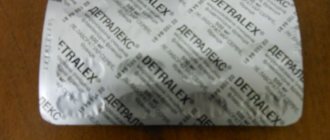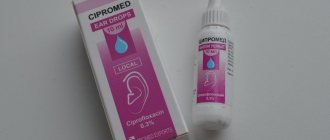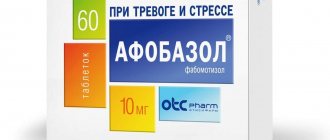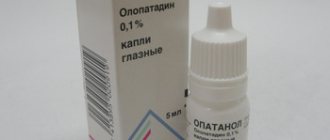"VENLAXOR": composition
The composition includes the drug:
- the main active ingredient is venlafaxine in dosages of 37.5 and 75 milligrams;
- anhydrous lactose;
- calcium hydrogen phosphate;
- sodium starch glycolate;
- anhydrous silica;
- magnesium stearate;
- dye.
Auxiliary components ensure that the drug retains its tablet form, and also simplify oral administration of tablets and ensure optimal absorption of the active substance. Despite the fact that Venlaxor has an antidepressant effect on the body. The drug does not directly relate to antidepressants. The drug is produced in the form of flat cylindrical tablets tinted with dye to a light pink hue. The drug is sold through pharmacy chains in two dosage options: 37.5 and 75 milligrams, 10 tablets in a foil blister and three blisters in an individual cardboard box. Each package of Velaxor contains instructions for use on paper.
Venlaxor®
As with other antidepressants, abrupt cessation of venlafaxine therapy - especially after high doses of the drug - may cause withdrawal symptoms, and therefore it is recommended to gradually reduce the dose before discontinuing the drug. The length of the period required to reduce the dose depends on the dose size, duration of therapy, as well as the individual sensitivity of the patient.
When prescribing Venlaxor® tablets to patients with lactose intolerance, it should be taken into account that each 37.5 mg tablet contains 30 mg of lactose, each 75 mg tablet contains 60 mg of lactose.
In patients with depressive disorders, the possibility of suicide attempts should be considered before initiating any drug therapy. Therefore, to reduce the risk of overdose, the initial dose of the drug should be as low as possible, and the patient should be under close medical supervision.
In patients with affective disorders, hypomanic or manic states may occur when treated with antidepressants (including venlafaxine). Like other antidepressants, venlafaxine should be used with caution in patients with a history of mania. Such patients require medical supervision.
Like other antidepressants, venlafaxine should be administered with caution to patients with a history of epileptic seizures. Treatment with venlafaxine should be interrupted if epileptic seizures occur.
Patients should be warned to seek immediate medical attention if rash, hives, or other allergic reactions occur.
Some patients experienced a dose-dependent increase in blood pressure while taking venlafaxine, and therefore regular monitoring of blood pressure is recommended, especially during the period of dose selection or increase.
The drug should be prescribed with caution for tachyarrhythmia, because There may be an increase in heart rate, especially when taking high doses.
Patients, especially the elderly, should be warned about the possibility of dizziness and impaired balance.
Like other serotonin reuptake inhibitors, venlafaxine may increase the risk of bleeding into the skin and mucous membranes. Caution is necessary when treating patients predisposed to such conditions.
While taking venlafaxine, especially in conditions of dehydration or decreased blood volume (including in elderly patients and patients taking diuretics), hyponatremia and/or syndrome of insufficient ADH secretion may occur.
Mydriasis may occur while taking the drug, and therefore it is recommended to monitor intraocular pressure in patients prone to increased pressure or with angle-closure glaucoma.
The use of venlafaxine has not been studied in patients with recent myocardial infarction and decompensated heart failure. The drug should be prescribed to such patients with caution.
It is necessary to monitor patients for signs of drug abuse, especially for patients with a history of such symptoms.
While taking venlafaxine, special caution should be exercised during electroconvulsive therapy, because There is no experience with the use of venlafaxine in these conditions.
Impact on the ability to drive vehicles and operate machinery
Although venlafaxine does not affect psychomotor and cognitive functions, it should be taken into account that any drug therapy with psychoactive drugs may reduce the ability to make judgments, think or perform motor functions. The patient should be warned about this before starting treatment. If such effects occur, the degree and duration of restrictions should be determined by a physician. Drinking alcohol is also not recommended.
How does it affect the body? (Pharmacodynamics)
The pharmacological effect of the drug on the body is determined by the properties of the main component. Despite the relative isolation of the drug from any of the known groups of antidepressants, Velaxor has a pronounced antidepressant effect. However, the therapeutic effect and the basis of the mechanism of action on humans are determined by increased transmission of nerve impulses. The active substance together with the metabolite is considered an inhibitor, that is, it inhibits the reuptake of serotonin and norepinephrine, and also partially inhibits the uptake of dopamine. During a course of treatment, patients experience a decrease in beta-adrenergic reactivity. At the same time, the drug is not tropic to receptors of opioid, benzodiazepine and non-cyclidine types. The medicine quickly dissolves in the acidic environment of the stomach and is actively absorbed in the gastrointestinal tract. The maximum concentration of the substance in the blood plasma is maintained for 24 hours after a single dose of the drug. It is completely metabolized in the liver, forming O-desmethylvenlafaxine, which is similar in effect to the active substance of the drug.
New possibilities for using Venlaxor for the treatment of depression in general medical practice
T.V. Reshetova, T.N. Zhigalova
St. Petersburg Medical Academy of Postgraduate Education, St. Petersburg
Depression is one of the most common mental disorders. At various periods of life, it occurs in 10% of the population, and taking into account minor forms, the frequency of depression in the population increases to 25%. However, only a quarter of such patients are seen by psychiatrists and psychotherapists, the rest are treated by general practitioners.
According to WHO forecasts, by 2021 depression will become the most important factor in disability throughout the world. It should be noted that views on depression are quite different: at different social levels, the same suffering is considered a disease, a consequence of bad upbringing, the sin of despondency, an obsession, a habitual inconvenience or a character trait. Cyclic mood swings in patients in general medical practice sometimes do not reach the level of psychotic maladaptation, but during “bad periods” (for several weeks or months), a person feels lethargy, loss of strength, is burdened by human society, preferring loneliness and inactivity. Appetite and assessment of personal qualities change in tune with mood, and the desire for new acquaintances decreases. By the patient and the doctor, this may be regarded as a decrease in mood associated with life difficulties or illness, but, from the point of view of a psychiatrist, such a condition is subject to diagnosis according to the criteria for depression from ICD-10.
In modern literature, views on mild forms of depression are very contradictory. Some authors consider latent depression to be the equivalent of situational maladaptation, others treat it as a psychiatric disease, emphasizing that insomnia, tachycardia, and autonomic dysfunction do exist in the patient; This is not a delusion of illness, since patients do not insist on their own assessment of health, but one of the clinical manifestations of depression. According to another opinion, latent (somatized, vegetative) depression, “depression without depression” is a link between mental and somatic diseases. According to the ICD-10 criteria, many “everyday” situations encountered in general medical practice should be classified as depression of varying severity and, therefore, may require treatment with antidepressants depending on the register of the lesion and the level of depression.
In general medical practice, in contrast to psychiatric services, “depression is more occupied with its body than other borderline disorders,” and patients actually present depressive complaints less frequently. The core syndrome in the clinic of a depressive state for an internist is often subthreshold asthenia, observed in 60-90% of patients, and only then depression. Somatic suffering or functional pathology of organs, as a rule, comes to the fore, and a decrease in mood is regarded by patients and doctors as an understandable reaction to the disease.
Somatogenic depression caused by the clinical picture of severe somatic illness deserves special attention. Their distinctive feature is the reduction of psychopathological symptoms in parallel with somatic improvement. In general medical practice, patients more often complain of anxiety, rather than of decline, which develops against a vital-asthenic background; half of the patients have suicidal thoughts and fear of death. Pain is the main complaint that the patient usually presents. However, with depression it is not even pain, but a painful, disturbing feeling in some specific place, a painful feeling of heaviness, discomfort, a syndrome of fear and anticipation of future pain.
In 31% of patients, a history of ambulatory depressive phases was assessed by general practitioners as vegetative-vascular dystonia, neurosis or osteochondrosis. At the same time, the patients had characteristic symptoms that allowed the internist to suspect depression behind the somatic facade of the disease: memory deterioration (except for memory for unpleasant things), forgetting successes and updating failures, a change in the sense of time and time perspective (life for today), difficulties in accepting the most ordinary decisions, especially simultaneous fear of doing and not doing something (for example, fear of taking a medicine because of side effects and not taking it because of the risk of worsening the course of the disease - “both are worse”), self-doubt, hyperesthesia in relation to strong or prolonged stimuli, difficulty forming concepts.
Many different schemes have been proposed for the correction of a depressive state in the clinic of internal diseases using drugs from the group of antidepressants. However, data from long-term follow-up studies indicate that in 25% of cases, patients develop persistent asthenic-depressive or depressive-hypochondriacal syndrome, both with and without the most intensive treatment of depression. Two thirds of patients in general medical practice, for various reasons (lack of information about the consequences, financial problems, self-medication), complete treatment for depression without completing the required course of therapy. This leads to rebound syndrome and the formation of resistance. It was the growth of resistant depression and the need to replace complex combined treatment of depression (drugs of several groups) with one drug that became the prerequisite for the creation of new antidepressants with a combined effect.
The latter include, in particular, Venlaxor. Venlaxor inhibits the reuptake of serotonin and norepinephrine, and is also a weak inhibitor of dopamine reuptake and weakens b-adrenergic reactions. Venlafaxine blocks serotonin reuptake approximately 5 times more strongly than norepinephrine reuptake. The degree of influence on neurotransmitter systems depends on the prescribed dose of venlafaxine: in small doses it only affects the uptake of serotonin; in medium and large - is an inhibitor of the reuptake of serotonin and norepinephrine; in very large cases, it blocks the reuptake of dopamine, serotonin and norepinephrine with equal effectiveness.
A serious issue is the time of onset of the effect. The effect of most known antidepressants usually appears in the third week of treatment. By this time, the doctor and the patient are relieved to note positive changes in the condition, and side effects are decreasing. The antidepressant effect of Venlaxor is detected somewhat earlier. Thus, in patients suffering from major depression from 6 months to 10 years, treatment with Venlaxor at a dose of 75-225 mg/day led to a significant improvement in the condition starting from the 7th day of therapy. The first response to treatment with Venlaxor was noted already on the 2-3rd day of use and was described by patients as a feeling of comfort. Significant changes in the PANSS, Beck, Hamilton and Taylor scales were observed in the 2nd week of therapy. In schizophrenia, the onset of the therapeutic effect, assessed on the PANSS scale, was observed from the 2nd week from the start of treatment with Venlaxor.
The rapidity of achieving an initial clinical response leads to a reduction in the risk of suicide, the frequency of treatment refusals and the number of hospitalizations in outpatients. Meta-analyses revealed the same effectiveness of venlafaxine with the most powerful tricyclic antidepressants and its advantage over selective serotonin reuptake inhibitors.
A high level of therapeutic response in the treatment of symptomatically different depressions has been demonstrated with the use of Venlaxor both in monotherapy and when combined with other drugs. Venlaxor has been noted to be highly effective in severe depression. The best results were obtained in patients with recurrent depression and bipolar affective disorders.
It should be noted that effectiveness is not the only necessary characteristic of therapy provided to patients with depression. Its tolerability is also the most important factor, especially in the treatment of somatogenic depression, in which patients are forced to take a large number of medications for somatic pathology.
Venlaxor is well tolerated. Side effects, if they develop, are more often observed at the beginning of therapy and usually disappear during the first week of treatment. The spectrum and severity of side effects are dose-dependent. When using venlafaxine in small and medium doses, it is possible to develop side effects inherent in all antidepressants from the group of selective serotonin reuptake inhibitors: dry mouth, nausea, insomnia, loss of appetite, fatigue, agitation, headache. Some side effects (decreased appetite and body weight) can be rationally used to treat related associated disorders (for example, eating disorders and nutritional obesity, which are often associated with depression).
When venlafaxine is prescribed in large doses, noradrenergic effects are possible: nausea, vomiting, sinus tachycardia, transient increase in blood pressure. If patients with somatic pathology (myocardial infarction or unstable angina in history, epilepsy, mania, glaucoma, renal or hepatic failure) require high doses of venlafaxine - more than 200 mg / day, it is necessary to monitor liver and kidney function, blood pressure levels during treatment and heart rate.
The good tolerability of Venlaxor with long-term use at a dose of 75 mg/day is confirmed by the absence of side effects in 95% of patients with post-stroke depression and an improvement in the quality of life of patients who have suffered a stroke.
Venlaxor (venlafaxine) is a drug for the treatment of depression in patients of different age groups. It is well tolerated by elderly patients, does not cause dependence or sedation, is characterized by low toxicity and a low risk of interaction with other drugs. Normally, in a healthy person, interoceptive sensations from working organs are subliminal and do not reach consciousness. In organic pathology, interoceptive sensations in places of the pathological process go far beyond the subthreshold level and are perceived as real pain. Also M.I. Astvatsaturov noticed that sensations from an organ with subclinical pathology are perceived to a slightly greater extent than from a healthy one. Lability of mood, weakness of concentration, decrease in higher integrative functions of the brain disrupt the adequate perception of sensations from one’s own body. Thus, both conditions for the formation of non-psychotic hypochondria are met, resulting in an incorrect interpretation of increased interoceptive sensations. Further, such a “pathological algic system” independently develops according to the laws of pathological dominance, greatly changing the clinical picture of any somatic disease that an elderly patient already has. With depression in older people, all perception thresholds change, including pain, and this creates an excellent basis for enhancing interoceptive sensations. Anxiety, usually observed in elderly patients, forces them to “listen” to their organs, and such an excessive anxious state can lead to cardio- and cancerophobia. Both serotonin and norepinephrine mediation are involved in many of the mechanisms of pathogenesis of this torpid clinical condition.
Venlafaxine, having a pathogenetic effect on the links of the pathological process, helps fight anxiety and hypochondriacal depression. Let us recall that depression in old age is characterized not so much by a strong decrease in mood as by an excessive clinical picture of existing somatic diseases, hypochondriacal fixation on them and pseudodementia. Unlike other antidepressants, Venlaxor helps improve memory and attention - indicators of the cognitive sphere that suffer from depression in older people. No dose adjustment is required when prescribing Venlaxor to elderly patients.
Thus, venlafaxine (Venlaxor) is one of the most promising representatives of the class of antidepressants, which has a dual mechanism of action (serotonergic and noradrenergic), which provides a more balanced effect on neurotransmission and synergism of psychopharmacological effects. Combining the high effectiveness of tricyclic antidepressants with the good tolerability and safety of selective antidepressants, Venlaxor can be successfully used in a wide range of depressive conditions of varying severity, in patients with anxiety and depressive disorders, in somatogenic and post-stroke depression, for the treatment of generalized anxiety, as well as in therapy depression resistant to selective serotonin reuptake inhibitors. The speed of onset of the initial clinical response determines the quality and durability of remission, and also reduces the total cost of treatment.
Indications for use:
The drug is intended for the treatment and prevention of depressive conditions of any etiology.
The list of the most common contraindications includes:
- allergic reactions to any of the components of the drug;
- children's age - up to 18 years;
- acute renal failure, as well as liver disease in acute and chronic form;
- for women of reproductive age - the period of pregnancy and breastfeeding;
- parallel use of MAO inhibitors;
The drug is prescribed only in case of urgent need under the constant supervision of a doctor for the following diseases and conditions:
- post-infarction period;
- arterial hypertension;
- unstable angina;
- history of convulsive syndrome and manic-depressive psychosis;
- high intraocular pressure;
- tachycardia;
- vascular weakness, predisposition to skin bleeding.
The drug belongs to the group of drugs and has a pronounced therapeutic effect, therefore, like any other potent drug, it has a number of side effects, namely:
- increased fatigue, weakness, dry mouth, nausea, vomiting, loss of appetite, constipation;
- weight loss, increased blood cholesterol, arterial hypertension, tachycardia;
- disturbances in sleep/wake patterns, nightmares, nervous overexcitation, dizziness, increased muscle tone, stupor, yawning, tremors, and epileptic seizures;
- possible loss of potency, enuresis or vice versa, urinary retention, menorrhagia, anorgasmia;
- impaired vision and accommodation, mydriasis, taste changes, increased sweating, hyperemia, erythema multiforme, skin rashes, hematomas on the mucous membranes and skin, thrombocytopenia, anaphylactic shock.
At the same time, it is not recommended to abruptly discontinue the drug; withdrawal provokes side effects from almost all organs and systems of the body. After a short time, the symptoms disappear.
Venlaxor
Use during pregnancy and breastfeeding
The safety of venlafaxine during pregnancy has not been proven, therefore the use of the drug during pregnancy (or suspected pregnancy) is contraindicated.
Women of childbearing age should be warned about this before starting treatment and should immediately consult a doctor if they become pregnant or plan to become pregnant during treatment with the drug. Women of childbearing potential should use appropriate contraception while taking venlafaxine.
If maternal treatment was completed shortly before delivery, the newborn may experience drug withdrawal symptoms.
Venlafaxine and its metabolite EDV are excreted in breast milk. The safety of these substances for newborns has not been proven, so taking venlafaxine during breastfeeding is not recommended. If it is necessary to take the drug during lactation, the issue of stopping breastfeeding should be decided.
Use for liver dysfunction
Contraindication: severe liver dysfunction.
In case of mild liver failure (prothrombin time (PT) less than 14 seconds), no adjustment of the dosage regimen is required. In case of moderate liver failure (PT from 14 to 18 seconds), the dose should be reduced by 50%.
Use for renal impairment
Contraindication: severe renal impairment (GFR less than 10 ml/min).
In case of mild renal failure (glomerular filtration rate (GFR) more than 30 ml/min), no dosage adjustment is required. For moderate renal failure (GFR 10-30 ml/min), the dose should be reduced by 25-50%. Due to the prolonged half-life of venlafaxine and its active metabolite EDV, such patients should take the entire dose once a day. It is not recommended to use venlafaxine in severe renal failure (GFR less than 10 ml/min), since there are no reliable data on such therapy. Patients on hemodialysis are prescribed 50% of the usual daily dose of venlafaxine after completion of hemodialysis.
Use in children
Contraindication: age under 18 years (safety and effectiveness for this category of patients have not been proven).
Use in elderly patients
Patients, especially the elderly, should be warned about the possibility of dizziness and impaired balance.
Elderly patients do not require dose changes, but caution must be exercised, for example, due to the possibility of impaired renal function. The lowest effective dose should be used. When increasing the dose, the patient should be under close medical supervision.
special instructions
As with other antidepressants, abrupt cessation of venlafaxine therapy - especially after high doses of the drug - may cause withdrawal symptoms, and therefore it is recommended to gradually reduce the dose before discontinuing the drug. The length of the period required to reduce the dose depends on the dose size, duration of therapy, as well as the individual sensitivity of the patient.
When prescribing Venlaxor® tablets to patients with lactose intolerance, it should be taken into account that each 37.5 mg tablet contains 30 mg of lactose, each 75 mg tablet contains 60 mg of lactose.
In patients with depressive disorders, the possibility of suicide attempts should be considered before initiating any drug therapy. Therefore, to reduce the risk of overdose, the initial dose of the drug should be as low as possible, and the patient should be under close medical supervision.
In patients with affective disorders, hypomanic or manic states may occur when treated with antidepressants (including venlafaxine). Like other antidepressants, venlafaxine should be used with caution in patients with a history of mania. Such patients require medical supervision.
Like other antidepressants, venlafaxine should be administered with caution to patients with a history of epileptic seizures. Treatment with venlafaxine should be interrupted if epileptic seizures occur.
Patients should be warned to seek immediate medical attention if rash, hives, or other allergic reactions occur.
Some patients experienced a dose-dependent increase in blood pressure while taking venlafaxine, and therefore regular monitoring of blood pressure is recommended, especially during the period of dose selection or increase.
The drug should be prescribed with caution for tachyarrhythmia, because There may be an increase in heart rate, especially when taking high doses.
Patients, especially the elderly, should be warned about the possibility of dizziness and impaired balance.
Like other serotonin reuptake inhibitors, venlafaxine may increase the risk of bleeding into the skin and mucous membranes. Caution is necessary when treating patients predisposed to such conditions.
While taking venlafaxine, especially in conditions of dehydration or decreased blood volume (including in elderly patients and patients taking diuretics), hyponatremia and/or syndrome of insufficient ADH secretion may occur.
Mydriasis may occur while taking the drug, and therefore it is recommended to monitor intraocular pressure in patients prone to increased pressure or with angle-closure glaucoma.
The use of venlafaxine has not been studied in patients with recent myocardial infarction and decompensated heart failure. The drug should be prescribed to such patients with caution.
It is necessary to monitor patients for signs of drug abuse, especially for patients with a history of such symptoms.
While taking venlafaxine, special caution should be exercised during electroconvulsive therapy, because There is no experience with the use of venlafaxine in these conditions.
Impact on the ability to drive vehicles and operate machinery
Although venlafaxine does not affect psychomotor and cognitive functions, it should be taken into account that any drug therapy with psychoactive drugs may reduce the ability to make judgments, think or perform motor functions. The patient should be warned about this before starting treatment. If such effects occur, the degree and duration of restrictions should be determined by a physician. Drinking alcohol is also not recommended.
"VENLAXOR": instructions for use
If the drug is taken incorrectly, an overdose is possible, which is expressed in the following symptoms:
- ventricular tachycardia;
- changes on the ECG;
- hypotension;
- bradycardia;
- changes in consciousness;
- convulsive syndrome.
It is strictly not recommended to take drugs together with taking psychotropic drugs, as well as alcoholic beverages of any strength and composition. Possible death! No specific antidote has been found. In case of overdose, general body cleansing and detoxification procedures are carried out with constant monitoring of breathing and blood circulation. Absorption of the active substance in case of overdose is blocked by taking activated carbon. Avoid artificially induced vomiting.
How to take it correctly?
According to the instructions for use, venlaxor is intended for oral administration with food - twice a day, one tablet of a smaller dosage in the morning and evening.
- The daily dose should not exceed 75 mg.
- If there is a stable lack of effect over two weeks of continuous use of the drug, it is allowed to increase the dosage.
- The decision to change the conditions of admission should be made only by the attending physician. Self-medication is unacceptable.
- Treatment of severe depressive conditions allows for increasing the dose to 150 mg per day with twice the dose of higher dosage tablets.
- The maximum permissible daily dose of the drug is 375 mg. After which the dosage must be gradually reduced.
- The course of prophylaxis can last up to six months, provided that a minimum dose of the drug is taken.
- Patients with moderate renal failure are prescribed half doses, as well as patients on hemodialysis.
- Severe renal failure precludes taking the drug completely.
Instructions:
Clinical and pharmacological group
02.002 (Antidepressant)
Release form, composition and packaging
The tablets are light pink with dark pink inclusions, flat-cylindrical, with a chamfer and a score on one side.
| 1 tab. | |
| venlafaxine (hydrochloride) | 37.5 mg |
| -«- | 75 mg |
Excipients: anhydrous calcium hydrogen phosphate, anhydrous lactose, sodium carboxymethyl starch, magnesium stearate, anhydrous colloidal silicon dioxide, red iron oxide dye (E172).
10 pieces. - blisters (3) - cardboard packs.
pharmachologic effect
Antidepressant. Based on its chemical structure, venlafaxine cannot be classified into any known class of antidepressants (tricyclic, tetracyclic, or others); it is a racemate of two active enantomers.
The mechanism of the antidepressant effect of the drug is associated with its ability to potentiate the transmission of nerve impulses to the central nervous system. Venlafaxine and its main metabolite O-desmethylvenlafaxine (ODV) are strong serotonin and norepinephrine reuptake inhibitors and weak dopamine reuptake inhibitors. In addition, venlafaxine and EDV reduce beta-adrenergic reactivity both after a single dose and with chronic use. Venlafaxine and EDV are equally effective in inhibiting the reuptake of neurotransmitters.
Venlafaxine has no affinity for m-cholinergic receptors, histamine H1 receptors and α1-adrenergic receptors of the brain. Venlafaxine does not inhibit MAO activity. Has no affinity for opioid, benzodiazepine, phencyclidine or NMDA receptors.
Pharmacokinetics
Suction
Venlafaxine is well absorbed from the gastrointestinal tract. After a single oral dose of 25-150 mg, Cmax in blood plasma is 33-172 ng/ml and is achieved within approximately 2.4 hours. After taking the drug with food, the time to reach Cmax in blood plasma increases by 20-30 minutes. however, the Cmax and absorbance values do not change.
Distribution and metabolism
Subject to intensive metabolism during the “first pass” through the liver. Its main metabolite is O-desmethylvenlafaxine (ODV). Cmax EDV in blood plasma of 61-325 ng/ml is achieved approximately 4.3 hours after administration. The binding of venlafaxine and EDV to plasma proteins is 27% and 30%, respectively.
With repeated administration of venlafaxine plasma Css and EDV are achieved within 3 days. In the range of daily doses of 75-450 mg, venlafaxine and EDV have linear kinetics.
Removal
T1/2 of venlafaxine and EDV are 5 and 11 hours, respectively. EDV and other metabolites, as well as unchanged venlafaxine, are excreted by the kidneys.
Pharmacokinetics in special clinical situations
In patients with liver cirrhosis, plasma concentrations of venlafaxine and EDV are increased, and their elimination rate is reduced.
In moderate or severe renal failure, the total clearance of venlafaxine and EDV is reduced, and T1/2 increases. A decrease in total clearance is mainly observed in patients with CC below 30 ml/min.
The age and gender of the patient do not affect the pharmacokinetics of the drug.
Dosage
It is recommended to take the tablets with meals.
The recommended starting dose is 75 mg in 2 divided doses (37.5 mg 2 times a day) daily. If after several weeks of treatment no significant improvement is observed, the daily dose can be increased to 150 mg (75 mg 2 times a day). If a higher dose is needed (major depressive disorder or other conditions requiring inpatient treatment), you can immediately prescribe 150 mg in 2 doses (75 mg 2 times a day). After this, the daily dose can be increased by 75 mg every 2-3 days until the desired therapeutic effect is achieved. The maximum daily dose of Venlaxor® is 375 mg. After achieving the required therapeutic effect, the daily dose can be gradually reduced to the minimum effective level.
Maintenance treatment (including for the prevention of relapses) can last 6 months or more. The minimum effective doses used in the treatment of a depressive episode are prescribed.
In case of mild renal failure (glomerular filtration rate (GFR) more than 30 ml/min), no dosage adjustment is required. For moderate renal failure (GFR 10-30 ml/min), the dose should be reduced by 25-50%. Due to the prolongation of T1/2 of venlafaxine and its active metabolite EDV, such patients should take the entire dose 1 time/day. It is not recommended to use venlafaxine in severe renal failure (GFR less than 10 ml/min), since there are no reliable data on such therapy. Patients on hemodialysis are prescribed 50% of the usual daily dose of venlafaxine after completion of hemodialysis.
In case of mild liver failure (prothrombin time (PT) less than 14 seconds), no adjustment of the dosage regimen is required. In case of moderate liver failure (PT from 14 to 18 seconds), the dose should be reduced by 50%. The use of venlafaxine in severe hepatic impairment is not recommended as reliable data on such therapy are lacking.
Elderly patients do not require dose changes, but caution must be exercised, for example, due to the possibility of impaired renal function. The lowest effective dose should be used. When increasing the dose, the patient should be under close medical supervision.
Stopping Venlaxor®
After discontinuation of Venlaxor®, it is recommended to gradually reduce the dosage of the drug over at least a week and monitor the patient's condition in order to minimize the risk associated with drug withdrawal.
The period required to completely stop taking the drug depends on its dosage, duration of treatment and the individual characteristics of the patient.
Overdose
Symptoms: ECG changes (prolongation of the QT interval, bundle branch block, expansion of the QRS complex), sinus or ventricular tachycardia, bradycardia, hypotension, convulsive states, changes in consciousness (decreased level of wakefulness). Death has been reported in overdoses of venlafaxine when taken concomitantly with alcohol and/or other psychotropic drugs.
Treatment: activated carbon is prescribed to reduce drug absorption. Inducing vomiting is not recommended due to the risk of aspiration. Symptomatic therapy is carried out. Specific antidotes are unknown. Continuous monitoring of vital functions (respiration and circulation) is recommended. Venlafaxine and its metabolite EDV are not eliminated by dialysis.
Drug interactions
The simultaneous use of MAO inhibitors and venlafaxine is contraindicated. Taking Venlaxor® can be started no less than 14 days after the end of therapy with MAO inhibitors. If a reversible MAO inhibitor (moclobemide) was used, this interval may be shorter (24 hours). Therapy with MAO inhibitors can be started no less than 7 days after discontinuation of Venlaxor®.
Venlafaxine does not affect the pharmacokinetics of lithium.
When used simultaneously with imipramine, the pharmacokinetics of venlafaxine and its metabolite EDV do not change.
When used simultaneously with haloperidol, the effect of the latter may be enhanced due to an increase in its concentration in the blood.
When used simultaneously with diazepam, the pharmacokinetics of the drugs and their main metabolites do not change significantly. There was also no effect on the psychomotor and psychometric effects of diazepam.
When used simultaneously with clozapine, an increase in its concentration in the blood plasma and the development of side effects (for example, epileptic seizures) may be observed.
When used simultaneously with risperidone (despite the increase in risperidone AUC), the pharmacokinetics of the sum of the active components (risperidone and its active metabolite) did not change significantly.
Venlaxor® enhances the effect of ethanol on psychomotor reactions.
The CYP2D6 isoenzyme converts venlafaxine into the active metabolite EDV. Unlike many other antidepressants, the dose of venlafaxine does not need to be reduced when co-administered with drugs that inhibit CYP2D6 activity, or in patients with a genetically determined decrease in CYP2D6 activity, since the total concentration of venlafaxine and its metabolite EDV will not change. The main route of elimination of venlafaxine involves metabolism by CYP2D6 and CYP3A4; therefore, special caution should be exercised when prescribing venlafaxine in combination with drugs that inhibit both of these enzymes. This drug interaction has not yet been studied.
Venlafaxine is a relatively weak inhibitor of CYP2D6 and does not suppress the activity of the CYP1A2, CYP2C9 and CYP3A4 isoenzymes; therefore, it should not be expected to interact with other drugs that are metabolized by these liver enzymes.
Cimetidine suppresses the metabolism during the “first pass” of venlafaxine through the liver and does not affect the pharmacokinetics of EDV. In most patients, only a slight increase in the overall pharmacological activity of venlafaxine and its metabolite EDV is expected (more pronounced in elderly patients and with impaired liver function).
No clinically significant interaction of venlafaxine with antihypertensive (including beta-blockers, ACE inhibitors and diuretics) and hypoglycemic drugs was detected.
Plasma protein binding is 27% for venlafaxine and 30% for EDV. Therefore, there was no effect on the concentration of drugs in the blood plasma that have a high degree of protein binding.
When taken simultaneously with warfarin, the anticoagulant effect of the latter may be enhanced.
When taken simultaneously with indinavir, the pharmacokinetics of indinavir changes (AUC decreases by 28%, Cmax by 36%), but the pharmacokinetics of venlafaxine and its metabolite EDV do not change. However, the clinical significance of this effect is unknown.
Use during pregnancy and lactation
The safety of venlafaxine during pregnancy has not been proven, therefore the use of the drug during pregnancy (or suspected pregnancy) is contraindicated. Women of childbearing age should be warned about this before starting treatment and should immediately consult a doctor if they become pregnant or plan to become pregnant during treatment with the drug.
Women of childbearing potential should use appropriate contraception while taking venlafaxine.
If maternal treatment was completed shortly before delivery, the newborn may experience drug withdrawal symptoms.
Venlafaxine and its metabolite EDV are excreted in breast milk. The safety of these substances for newborns has not been proven, so taking venlafaxine during breastfeeding is not recommended. If it is necessary to take the drug during lactation, the issue of stopping breastfeeding should be decided.
Side effects
Most side effects are dose dependent. With long-term treatment, the severity and frequency of most of these effects decreases, and there is no need to discontinue therapy. Determination of the frequency of side effects: often (>1%), infrequently (0.1-1%), rarely (0.01-0.1%), very rarely (<0.01%).
From the side of the central nervous system: often - dizziness, asthenia, insomnia, nightmares, increased nervous excitability, paresthesia, muscle hypertonicity, tremor, sedation; infrequently - apathy, hallucinations, myoclonus, fainting; rarely - convulsions, manic disorders, NMS.
From the cardiovascular system: often - increased blood pressure, hyperemia of the skin; uncommon - decreased blood pressure, postural hypotension, tachycardia; very rarely - changes in the QT interval, ventricular fibrillation, ventricular tachycardia (including ventricular fibrillation).
From the digestive system: often - loss of appetite, nausea, vomiting; infrequently - bruxism (involuntary grinding of teeth), increased activity of liver transaminases; rarely - hepatitis.
From the reproductive system: often - decreased libido, erectile dysfunction and/or ejaculation, anorgasmia, menorrhagia; infrequently - impaired orgasm in women.
From the urinary system: often - difficulty urinating; infrequently - urinary retention.
From the senses: often - disturbance of accommodation, mydriasis, blurred vision; infrequently - disturbance of taste perception.
From the hematopoietic organs: frequency unknown - agranulocytosis, aplastic anemia, neutropenia, pancytopenia.
Allergic reactions: infrequently - rash, photosensitivity; very rarely - exudative erythema multiforme (including Stevens-Johnson syndrome), anaphylaxis.
Laboratory indicators: infrequently - thrombocytopenia; rarely - increased bleeding time, hyponatremia; with long-term administration and use in high doses - hypercholesterolemia.
Other: often - weight loss, sweating (including night sweats); infrequently - ecchymosis, weight gain; rarely - syndrome of inadequate secretion of ADH, serotonin syndrome (nausea, vomiting, abdominal pain, diarrhea, flatulence, psychomotor agitation, tachycardia, hyperthermia, muscle rigidity, convulsions, myoclonus, sweating, depression of consciousness of varying severity).
If withdrawal syndrome occurs: dizziness, headache, asthenia, increased fatigue, sleep disturbances (changes in the nature of dreams, drowsiness or insomnia, difficulty falling asleep), hypomania, anxiety, increased nervous excitability, confusion, paresthesia, increased sweating, dry mouth, loss of appetite, nausea, vomiting, diarrhea (most of these reactions are mild and do not require treatment).
Storage conditions and periods
The drug should be stored out of the reach of children, protected from light at a temperature not exceeding 25°C. Shelf life: 3 years.
Indications
- depression of various etiologies (treatment and prevention).
Contraindications
- severe renal dysfunction (GFR less than 10 ml/min);
- severe liver dysfunction;
- simultaneous use of MAO inhibitors;
- age under 18 years (safety and effectiveness for this category of patients have not been proven);
- established or suspected pregnancy;
- lactation period (breastfeeding);
- hypersensitivity to the components of the drug.
The drug should be prescribed with caution in cases of recent myocardial infarction, unstable angina, arterial hypertension, tachycardia, history of convulsive syndrome, increased intraocular pressure, angle-closure glaucoma, history of manic states, predisposition to bleeding from the skin and mucous membranes, initially reduced weight body, hyponatremia, hypovolemia, concomitant use of diuretics, suicidal tendencies, renal or liver failure.
special instructions
As with other antidepressants, abrupt cessation of venlafaxine therapy - especially after high doses of the drug - may cause withdrawal symptoms, and therefore it is recommended to gradually reduce the dose before discontinuing the drug. The length of the period required to reduce the dose depends on the dose size, duration of therapy, as well as the individual sensitivity of the patient.
When prescribing Venlaxor® tablets to patients with lactose intolerance, it should be taken into account that each 37.5 mg tablet contains 30 mg of lactose, each 75 mg tablet contains 60 mg of lactose.
In patients with depressive disorders, the possibility of suicide attempts should be considered before initiating any drug therapy. Therefore, to reduce the risk of overdose, the initial dose of the drug should be as low as possible, and the patient should be under close medical supervision.
In patients with affective disorders, hypomanic or manic states may occur when treated with antidepressants (including venlafaxine). Like other antidepressants, venlafaxine should be used with caution in patients with a history of mania. Such patients require medical supervision.
Like other antidepressants, venlafaxine should be administered with caution to patients with a history of epileptic seizures. Treatment with venlafaxine should be interrupted if epileptic seizures occur.
Patients should be warned to seek immediate medical attention if rash, hives, or other allergic reactions occur. In some patients, while taking venlafaxine, a dose-dependent increase in blood pressure was noted, and therefore regular blood pressure monitoring is recommended, especially during the period of dose selection or increase.
The drug should be prescribed with caution for tachyarrhythmia, because There may be an increase in heart rate, especially when taking high doses.
Patients, especially the elderly, should be warned about the possibility of dizziness and impaired balance.
Like other serotonin reuptake inhibitors, venlafaxine may increase the risk of bleeding into the skin and mucous membranes. Caution is necessary when treating patients predisposed to such conditions.
While taking venlafaxine, especially in conditions of dehydration or decreased blood volume (including in elderly patients and patients taking diuretics), hyponatremia and/or syndrome of insufficient secretion of antidiuretic hormone may occur.
Mydriasis may occur while taking the drug, and therefore it is recommended to monitor intraocular pressure in patients prone to increased pressure or with angle-closure glaucoma.
The use of venlafaxine has not been studied in patients with recent myocardial infarction and decompensated heart failure. The drug should be prescribed to such patients with caution.
It is necessary to monitor patients for signs of drug abuse, especially for patients with a history of such symptoms.
While taking venlafaxine, special caution should be exercised during electroconvulsive therapy, because There is no experience with the use of venlafaxine in these conditions.
Impact on the ability to drive vehicles and operate machinery
Although venlafaxine does not affect psychomotor and cognitive functions, it should be taken into account that any drug therapy with psychoactive drugs may reduce the ability to make judgments, think or perform motor functions. The patient should be warned about this before starting treatment. If such effects occur, the degree and duration of restrictions should be determined by a physician. Drinking alcohol is also not recommended.
Use for renal impairment
Contraindication: severe renal impairment (GFR less than 10 ml/min).
In case of mild renal failure (glomerular filtration rate (GFR) more than 30 ml/min), no dosage adjustment is required. For moderate renal failure (GFR 10-30 ml/min), the dose should be reduced by 25-50%. Due to the prolonged half-life of venlafaxine and its active metabolite EDV, such patients should take the entire dose once a day. It is not recommended to use venlafaxine in severe renal failure (GFR less than 10 ml/min), since there are no reliable data on such therapy. Patients on hemodialysis are prescribed 50% of the usual daily dose of venlafaxine after completion of hemodialysis.
Use for liver dysfunction
Contraindication: severe liver dysfunction.
In case of mild liver failure (prothrombin time (PT) less than 14 seconds), no adjustment of the dosage regimen is required. In case of moderate liver failure (PT from 14 to 18 seconds), the dose should be reduced by 50%.
Conditions for dispensing from pharmacies
The drug is available with a prescription.
"VENLAXOR": analogues and their price
If it is impossible to purchase the drug or if you are highly sensitive to one of its components, you can consider taking such Venlaxor analogues as:
| Venlafaxine is a Russian antidepressant produced in tablets. The active component is the substance of the same name. The drug is prescribed for the treatment and prevention of relapses of depressive disorders and anxiety. Price – 321 rubles. |
| Velaxin is a Hungarian antidepressant based on venlafaxinum. Available in tablet form at 37.5, 75 and 150 milligrams. Prescribed for the treatment of depressive conditions. Price – from 814 rubles. |
| Velafax MV is a tablet from the Croatian pharmaceutical company Pliva, based on venlafaxine hydrochloride in the treatment of depression of any etiology. Price – 536 rubles. |
| Newelong are Spanish tablets produced in different dosages (75, 150 and 225 mg). Helps in the treatment and prevention of relapses of panic disorders, phobias and depression. Price – from 773 rubles. |
"VENLAXOR": reviews
At first, I didn’t understand the result a little, but over time, after the cumulative effect, I noticed significant improvements. I took 150 mg twice a day in the morning and evening, respectively (as prescribed by the doctor). I liked the fact that the weight began to come off quickly and there was no swelling, as with many similar drugs. Overall, it’s a good drug, I can recommend it; after using it, my figure quickly returned to the desired parameters.
It often happened that I woke up and had a terrible hangover, my head was pounding, nausea, I felt anxious, I couldn’t even lift my head from the pillow. I tried many different strong remedies, but it didn’t really help. And this drug coped well with hangover syndrome and anxiety. By the way, after many analogue drugs, you feel drowsy, but after this drug I didn’t notice anything like that - a huge plus if the work is concentrated, or you need to drive.
If you suffer from panic attacks, depression and anxiety, then you know how difficult it can be to deal with it all. It’s difficult to even ride the bus and communicate with people; getting a job is a whole ordeal. The psychotherapist advised me to take Venlaxor. I first read the reviews about the drug and realized that the antidepressant, in principle, should turn out to be quite good and reliable. I took the drug for literally several months, and improvements appeared. I began to communicate more calmly with people, my anxiety decreased, and I even wanted more communication. I took 150 mg as prescribed by the doctor. Now I take Venlaxor courses periodically, when I feel that stress is accumulating, it helps me. Quite a strong remedy.









